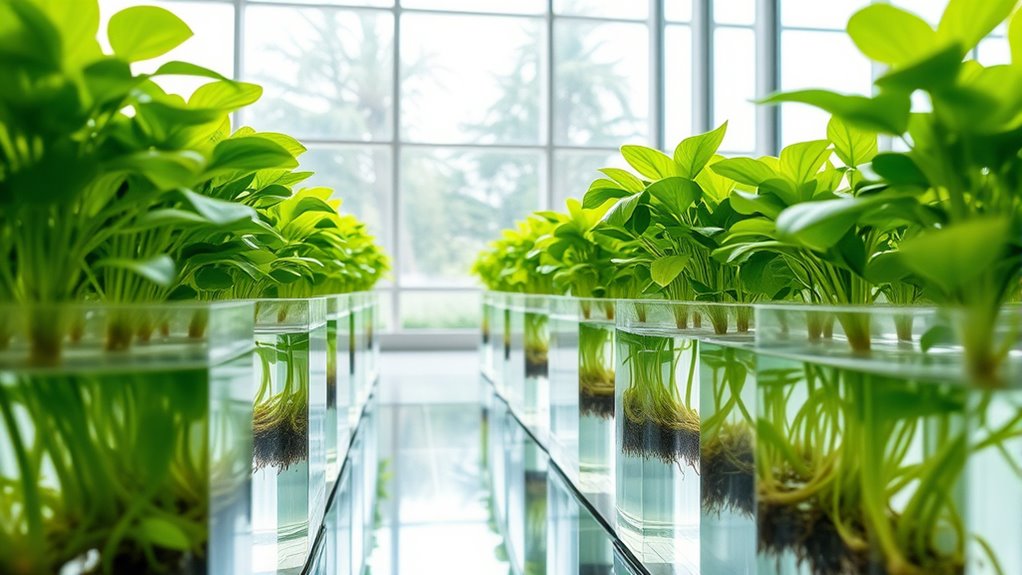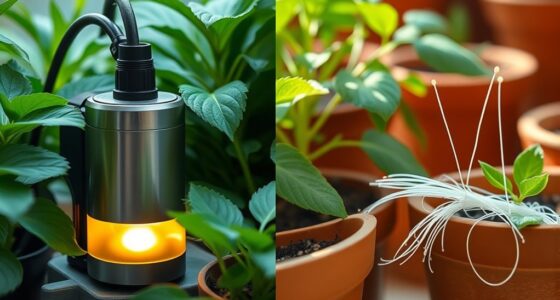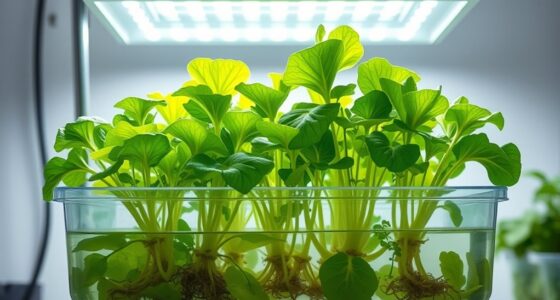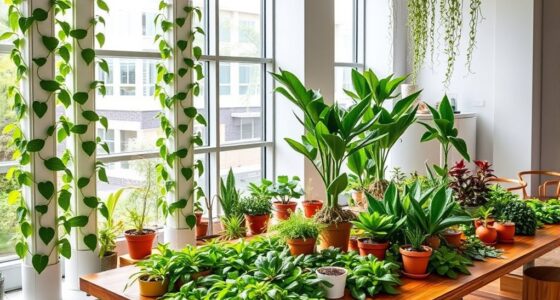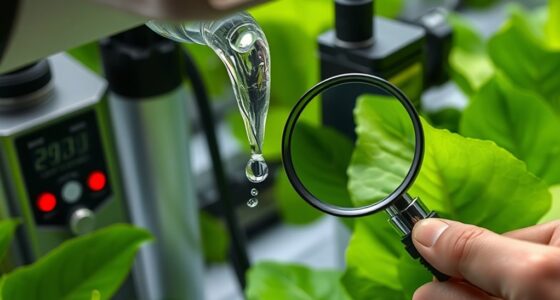Switching to water-based growing systems helps you stop soil messes and keeps your space clean. These systems use nutrient-rich water instead of soil, so you avoid dirty spills and muddy footprints. They’re easy to maintain, conserve water, and promote healthier plant growth. Plus, you can grow indoors or in small spaces without the hassle of soil. Curious how these systems can transform your gardening? Keep exploring to discover more benefits.
Key Takeaways
- Water-based systems eliminate soil, preventing messes and reducing cleanup time in indoor or confined spaces.
- Hydroponics uses nutrient-rich water solutions, minimizing spills and soil-related debris during planting and maintenance.
- Reusable recirculating systems reduce waste and contain water, keeping growing areas clean and tidy.
- Precise control of nutrients and environment decreases the risk of soil-borne pests and diseases, maintaining cleanliness.
- Hydroponic setups are ideal for small or indoor spaces, offering a neat, soil-free alternative for urban gardening.

Water-based growing systems, also known as hydroponics, offer an efficient way to cultivate plants without soil. Instead of traditional gardening methods that can be messy and labor-intensive, hydroponics provides a clean, controlled environment where you can grow healthy plants with less effort. One of the primary hydroponic advantages is the ability to precisely deliver nutrient solutions directly to the roots, ensuring plants get exactly what they need for ideal growth. This targeted feeding reduces waste and minimizes the risk of pests and diseases that often thrive in soil.
Since you’re not dealing with soil, cleanup becomes much easier. You won’t have to worry about dirt tracking through your space or dealing with soil-borne issues. Instead, the system relies on water and specially formulated nutrient solutions, which you can monitor and adjust easily. This means you spend less time on maintenance and more on enjoying your plants. The controlled environment also means you can grow a wide variety of plants indoors or in confined spaces, making it perfect for urban settings or areas with poor soil quality. Proper sealing mechanisms in some hydroponic systems can further enhance the efficiency by maintaining consistent internal conditions.
Hydroponic systems often incorporate recirculating nutrient solutions, which reuse water efficiently and reduce waste. This sustainability aspect is a significant advantage if you’re environmentally conscious. Plus, since the plants are rooted in a water-based medium—such as perlite, coconut coir, or a nutrient film—you can see their roots clearly, making it easier to diagnose issues early. This transparency allows you to maintain the right balance of nutrients and water, ensuring healthy development without guesswork.
Additionally, because hydroponic setups can be tailored to specific plant needs, you can achieve faster growth rates compared to traditional soil gardening. The direct access to nutrient solutions means plants absorb nutrients more readily, often leading to quicker harvest times. This is especially useful if you’re growing herbs, vegetables, or flowers and want to maximize productivity within a limited space. Utilizing airtight systems can further improve the control over environmental conditions, boosting growth efficiency.
Frequently Asked Questions
What Are the Initial Setup Costs for Water-Based Systems?
When considering water-based systems, your initial setup costs depend on factors like system size and complexity. You should conduct a thorough cost analysis to understand expenses for equipment, containers, and pumps. Additionally, look into financing options, such as loans or grants, to make the investment more manageable. Planning ahead helps guarantee you’re prepared financially and can make informed decisions about your water-based growing system setup.
How Do Water-Based Systems Impact Plant Nutrient Management?
Water-based systems give you better control over plant nutrient management. You can optimize nutrient levels more precisely, ensuring your plants get exactly what they need for healthy growth. pH regulation is easier, helping prevent deficiencies or toxicities. This system’s flexibility allows you to adjust nutrient solutions quickly, promoting consistent growth and higher yields. Overall, water-based systems streamline nutrient management, making it simpler and more efficient to nurture your plants effectively.
Are Water-Based Growing Systems Suitable for All Plant Types?
Water-based growing systems aren’t suitable for all plant types, as plant compatibility varies. You should consider each plant’s specific needs and growth habits to determine if these systems work well. They offer excellent system scalability for many crops, but some plants with extensive root systems or special requirements might not thrive. Assess your plants’ requirements carefully to choose the right system for ideal growth and efficiency.
What Maintenance Is Required for Water-Based Systems?
You need to regularly check your water quality to prevent nutrient imbalances and ensure healthy plant growth. System sanitation is essential—clean your water-based system frequently to avoid algae buildup and disease. Replace the water as needed, and monitor pH levels. Keeping everything clean and maintaining good water quality helps your system run smoothly, reduces problems, and keeps your plants thriving.
How Do Water-Based Systems Compare to Traditional Soil Methods?
Water-based systems often outperform traditional soil methods by promoting better soil health and reducing pest control issues. You’ll find they require less maintenance related to soil quality and pest management since you’re not dealing with soil-borne pests or nutrient imbalances. This means healthier plants and fewer worries about soil degradation. Plus, water systems can be more efficient, saving you time and resources while supporting sustainable growth practices.
Conclusion
Are you ready to ditch the dirt and embrace water-based growing systems? They offer a cleaner, more efficient way to cultivate your plants while reducing mess and environmental impact. With less soil to manage, you’ll enjoy a simpler, more sustainable gardening experience. So, why not give water-based systems a try and see how easy and rewarding modern farming can be? After all, isn’t it time to grow smarter, cleaner, and greener?
